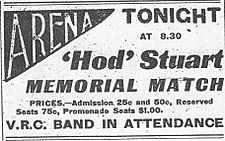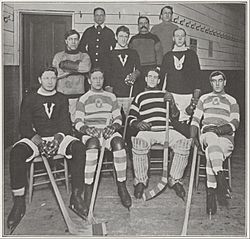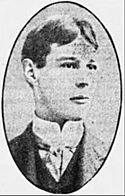Hod Stuart facts for kids
Quick facts for kids Hod Stuart |
|||
|---|---|---|---|
| Hockey Hall of Fame, 1945 | |||
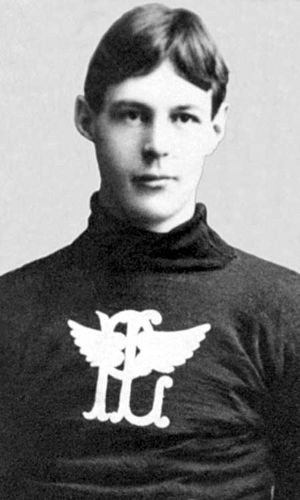 |
|||
| Born | February 20, 1879 Ottawa, Ontario, Canada |
||
| Died | June 23, 1907 (aged 28) Bay of Quinte, Ontario, Canada |
||
| Height | 6 ft 0 in (183 cm) | ||
| Weight | 190 lb (86 kg; 13 st 8 lb) | ||
| Position | Cover-point | ||
| Played for | Montreal Wanderers Pittsburgh Professionals Calumet Miners Portage Lakes Hockey Club Pittsburgh Bankers Quebec Bulldogs Ottawa Hockey Club |
||
| Playing career | 1902–1907 | ||
William Hodgson "Hod" Stuart (born February 20, 1879 – died June 23, 1907) was a Canadian professional ice hockey player. He was a "cover-point," which is what we now call a defenceman. Hod played for nine seasons with many different teams. He also played a little bit of football for the Ottawa Rough Riders.
With his brother Bruce, Hod played in the first professional ice hockey league. This was the American-based International Professional Hockey League (IPHL). He was seen as one of the best players in that league.
Hod was not happy with how rough and violent the IPHL games often were. He left the league in late 1906 and went back to Canada. In 1907, he helped the Montreal Wanderers win the Stanley Cup. This is hockey's top championship trophy. Sadly, two months later, he died in a diving accident.
To help his wife and children, the Eastern Canada Amateur Hockey Association held a special all-star game. This was the first game of its kind in any sport! About 3,800 people watched the Hod Stuart Memorial Game on January 2, 1908. The Montreal Herald newspaper called it "unique in the history of hockey."
Back then, defencemen usually stayed back on defense. But Hod Stuart was special because he could score goals while playing defense. He was also known for staying calm during games that often got very rough. He worked to make the game less violent and to help players earn more money. His efforts were remembered when the Hockey Hall of Fame started in 1945. He was one of the first nine players to be chosen for the Hall of Fame. His brother Bruce joined him there in 1961.
Contents
Early Life and Other Sports
Hod Stuart was born in Ottawa, Ontario. He was the oldest son of William Stuart and Rachel Hodgson. He had two brothers, Alex and Bruce, and two sisters, Jessie and Lottio. Hod loved sports from a young age. His father was a good lacrosse player and a good curler. Both Hod and Bruce played hockey when they were young. They often played on the same teams. Hod also played rugby and football. He played for the local professional football team, the Ottawa Rough Riders.
Outside of hockey, Hod worked as a bricklayer. Later, he also worked with his father in construction. People said he was a quiet person. Unlike other athletes, he did not brag about his achievements. He only talked about them with his close friends. He married his wife, Loughlin, around 1903. They had two children together.
Hockey Career
Hod first played for a senior hockey team in the winter of 1895–1896. This was with the Rat Portage Thistles in northwestern Ontario. In 1899, Hod and his brother Bruce joined the Ottawa Hockey Club. This team was part of the Canadian Amateur Hockey League (CAHL). He played for Ottawa in the 1900 season and was the team captain.
In 1900, Hod moved to Quebec for a job. He then joined the Quebec Bulldogs, also in the CAHL. He scored seven goals in fifteen games over the next two seasons.
In 1902, the Pittsburgh Bankers signed Hod to play professionally. He was offered a salary of US$15–20 each week. He also got a steady income from a day job in Pittsburgh. Hod scored seven goals and had eight assists in 1903. He was named the best cover-point in the league.
After one season in Pittsburgh, Hod moved to the Portage Lakes Hockey Club. This team was in northern Michigan. He played in fourteen exhibition games in the 1903–1904 season. He scored thirteen goals for the team.
When the International Professional Hockey League (IPHL) started, Hod left Portage Lake. He joined the Calumet Miners. He was a coach, manager, and player for $1,800. He scored eighteen goals for Calumet in 1904–1905. He helped the team win the league championship. He was again named the best cover-point in the league.
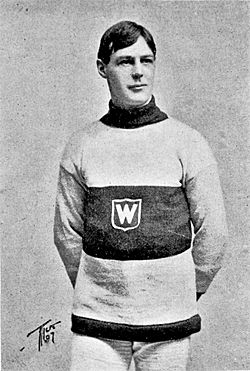
On December 11, 1905, Hod was suspended from the IPHL. Teams from the west complained he had won too many championships and was too rough. He was allowed to play again on December 30. He then joined the Pittsburgh Professionals. After Pittsburgh finished their season, Hod played one game for Calumet. They were trying to win the league championship, but lost to Portage Lakes. He was again named the best cover-point in the IPHL. He scored eleven goals that season. Hod was a big player and a smooth skater. He was seen as the best defenceman of his time. He was great at both offense and defense.
The IPHL paid players to move to the United States. Canadian teams had to pay similar salaries to keep their players. Hod was not happy playing in Pittsburgh because of how violent the games were. He heard that the Montreal Wanderers wanted him. They were the defending Stanley Cup winners. They offered to make him the highest-paid player in hockey.
On December 13, 1906, Hod wrote a letter in the Montreal Star newspaper. He explained his problems with the IPHL. His main concern was the referees. He said they "don't know how to run hockey over here." Pittsburgh's management thought Hod was causing trouble. They released him from the team.
Hod then joined the Wanderers. His first game with them was watched by 6,069 fans. This was one of the biggest crowds for a hockey game in Canada at that time. He played in the Wanderers' Stanley Cup challenge against the New Glasgow Cubs. This was on December 27 and 29, 1906. Hod and his teammates became the first professional hockey players to play for the Stanley Cup.
Even in the ECAHA, Hod faced rough play. On January 12, 1907, the Wanderers played the Ottawa Senators. The Wanderers won 4–2. During the game, players from Ottawa hit Wanderers players with their sticks. Hod was hit across the head but did not fight back. People praised him for staying calm. At a league meeting, some teams wanted to suspend the Ottawa players. But this idea was voted down. The league president resigned. The next time the Senators played in Montreal, the police arrested some Ottawa players. They were fined for their actions.
Despite the violence, Hod helped the Wanderers have a perfect season. They then played the Kenora Thistles for the Stanley Cup. The Thistles won the series in January. But the Wanderers won a rematch in March, getting the Cup back. Hod played in both challenges. He did not score any goals, but he played one of his best games. He was seen as the most important player on the Wanderers. He knew how to play every position and shared his knowledge with his teammates.
Hod Stuart's Death

After winning the Stanley Cup in 1907, Hod Stuart quit hockey. He was tired of the constant rough play. He went to work with his father in construction. As part of his job, Hod went to Belleville, Ontario. He was there to help build the Belleville Drill Shed. Even there, he kept getting offers to join new hockey teams.
On the afternoon of June 23, 1907, Hod went swimming with friends. This was in the Bay of Quinte, near Belleville. He swam to a nearby lighthouse, about half a kilometer away. He climbed onto a platform and dived into the water. The water was shallow, and he hit jagged rocks. He hurt his head and broke his neck. He died right away. His body was brought back to Ottawa. A service was held at his family's home. He was buried at Beechwood Cemetery.
The First All-Star Game
To raise money for Hod's wife and two children, the ECAHA decided to hold an all-star game. This was the first game of its kind in any sport! About 3,800 people came to the Hod Stuart Memorial Game on January 2, 1908. Tickets sold out days before the game. The Montreal Herald newspaper called the event "unique in the history of hockey."
The game featured the Montreal Wanderers, Hod's old team. They played against a team of top players from other ECAHA teams. The Westmount Arena let them use their rink for free. All the money from the game went to Hod's family. They raised over $2,100. Fans could mail in their choices for the all-star team. Winners got two tickets to the game. The Wanderers were an established team. They played better than the All-Stars, who had to learn to play together. The Wanderers won the game 10–7.
Game Roster
| Wanderers (10) | Position | All-Stars (7) |
|---|---|---|
| Riley Hern | Goaltender | Percy LeSueur (Ottawa) |
| Art Ross | Point | Rod Kennedy (Victorias) |
| Walter Smaill | Cover-point | Frank Patrick (Victorias) |
| Frank Glass | Rover | Joe Power (Quebec) |
| Ernie Russell | Centre | Grover Sargent (Montreal) |
| Cecil Blachford | Right Wing | Ed Hogan (Quebec) |
| Ernie Johnson | Left Wing | Jack Marshall (Shamrocks) |
Hod Stuart's Legacy and Playing Style
After Hod Stuart's death, many people in the hockey community shared their sadness. They also paid tribute to him. People from many sports clubs attended his funeral. They all said how much they would miss one of Ottawa's best athletes. James Strachan, president of the Montreal Wanderers, called him "a splendid hockey player." He also said Hod was "one of the finest fellows in the game."
Around the time of his death, Hod Stuart was often talked about. People said he was one of the best defencemen. Many thought he was one of the best players overall. Lorne Campbell, a forward from Montreal, played with Hod in Pittsburgh. In 1908, he said Hod was the best defenceman ever. He also said Hod helped change the game. Hod showed that defencemen could also rush the puck forward.
Lorne Campbell also said that Hod looked slow on the ice. But this was just because of his unique skating style. For a big player, Hod was "the speediest that ever drew on a pair of skates." Campbell also praised Hod's stickhandling skills and his long reach. He called Hod "one of the best generals in the game."
Campbell also said that Hod was not a dirty player. Even though he played in many rough games, he was often the one getting hit. Campbell said Hod "was able to take care of himself on the ice." He added that stories about Hod trying to hurt other players were not true. Hod often got hit on his hands with sticks. So, he designed a special hockey glove. It had extra padding to protect his hands.
Career Statistics
| Regular season | Playoffs | |||||||||||||
|---|---|---|---|---|---|---|---|---|---|---|---|---|---|---|
| Season | Team | League | GP | G | A | Pts | PIM | GP | G | A | Pts | PIM | ||
| 1898–99 | Ottawa Hockey Club | CAHL | 3 | 1 | 0 | 1 | — | — | — | — | — | — | ||
| 1899–1900 | Ottawa Hockey Club | CAHL | 7 | 5 | 0 | 5 | — | — | — | — | — | — | ||
| 1900–01 | Quebec Bulldogs | CAHL | 7 | 2 | 0 | 2 | — | — | — | — | — | — | ||
| 1901–02 | Quebec Bulldogs | CAHL | 8 | 5 | 0 | 5 | — | — | — | — | — | — | ||
| 1902–03 | Pittsburgh Bankers | WPHL | 13 | 7 | 8 | 15 | 29 | 4 | 1 | 2 | 3 | 2 | ||
| 1903–04 | Portage Lakes Hockey Club | Exhib | 14 | 13 | 0 | 13 | 23 | 9 | 4 | 0 | 4 | 12 | ||
| 1904–05 | Calumet Miners | IPHL | 22 | 18 | 0 | 18 | 19 | — | — | — | — | — | ||
| 1905–06 | Pittsburgh Professionals | IPHL | 20 | 11 | 0 | 11 | 50 | — | — | — | — | — | ||
| 1905–06 | Calumet Miners | IPHL | 1 | 0 | 0 | 0 | 0 | — | — | — | — | — | ||
| 1906–07 | Pittsburgh Professionals | IPHL | 4 | 1 | 3 | 4 | 19 | — | — | — | — | — | ||
| 1906–07 | Montreal Wanderers | ECAHA | 8 | 3 | 0 | 3 | 21 | — | — | — | — | — | ||
| 1906–07 | Montreal Wanderers | St-Cup | — | — | — | — | — | 4 | 0 | 0 | 0 | 8 | ||
| CAHL totals | 25 | 13 | 0 | 13 | — | — | — | — | — | — | ||||
| WPHL totals | 13 | 7 | 8 | 15 | 29 | 4 | 1 | 2 | 3 | 2 | ||||
| IPHL totals | 47 | 30 | 3 | 33 | 88 | — | — | — | — | — | ||||
| ECAHA totals | 8 | 3 | 0 | 3 | 21 | — | — | — | — | — | ||||
Playing stats from Total Hockey
Awards and Honors
WPHL Awards
| Award | Year(s) |
|---|---|
| First All-Star Team | 1903 |
IPHL Awards
| Award | Year(s) |
|---|---|
| First All-Star Team | 1905, 1906 |
Awards from Total Hockey
See also
- List of ice hockey players who died during their playing career



